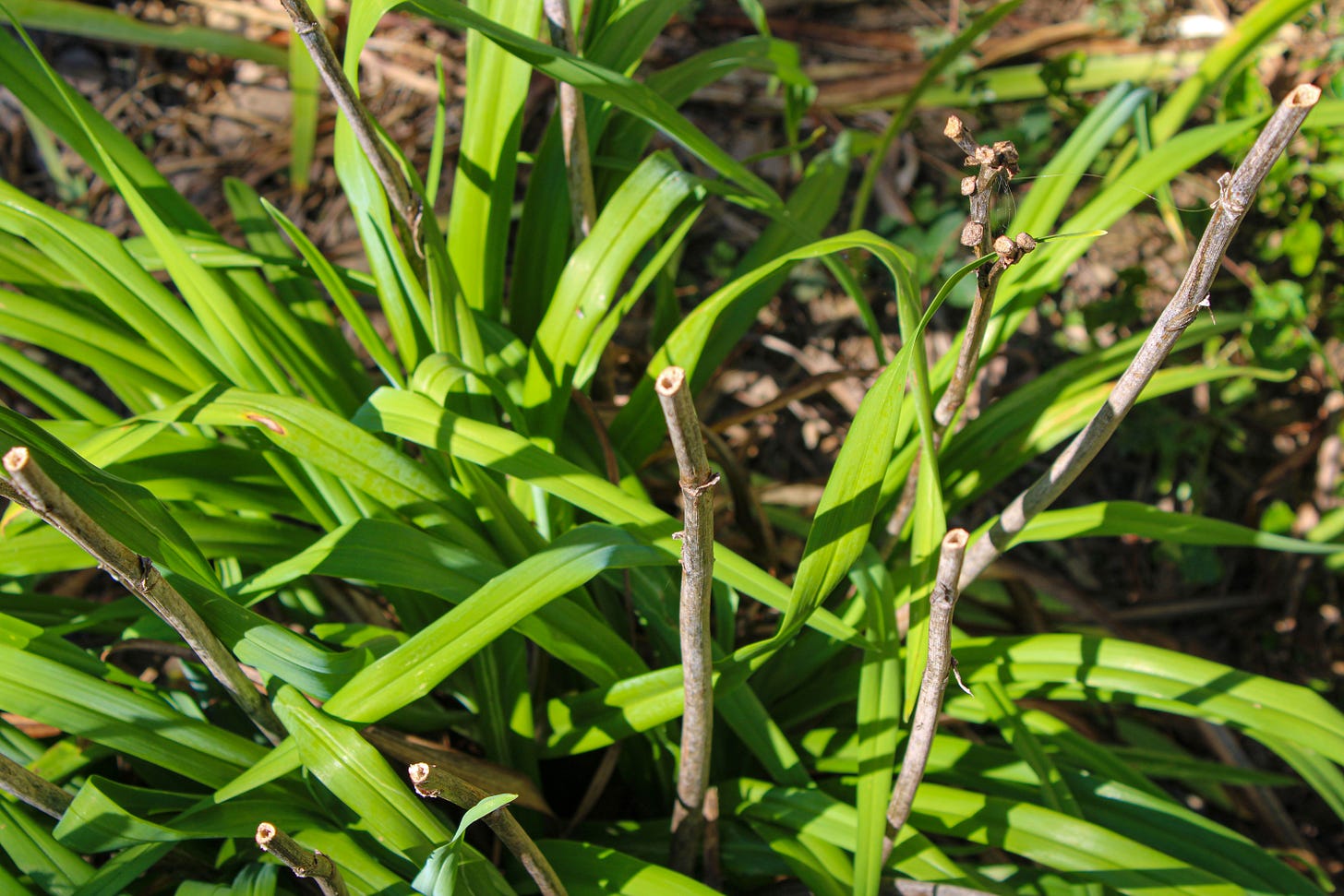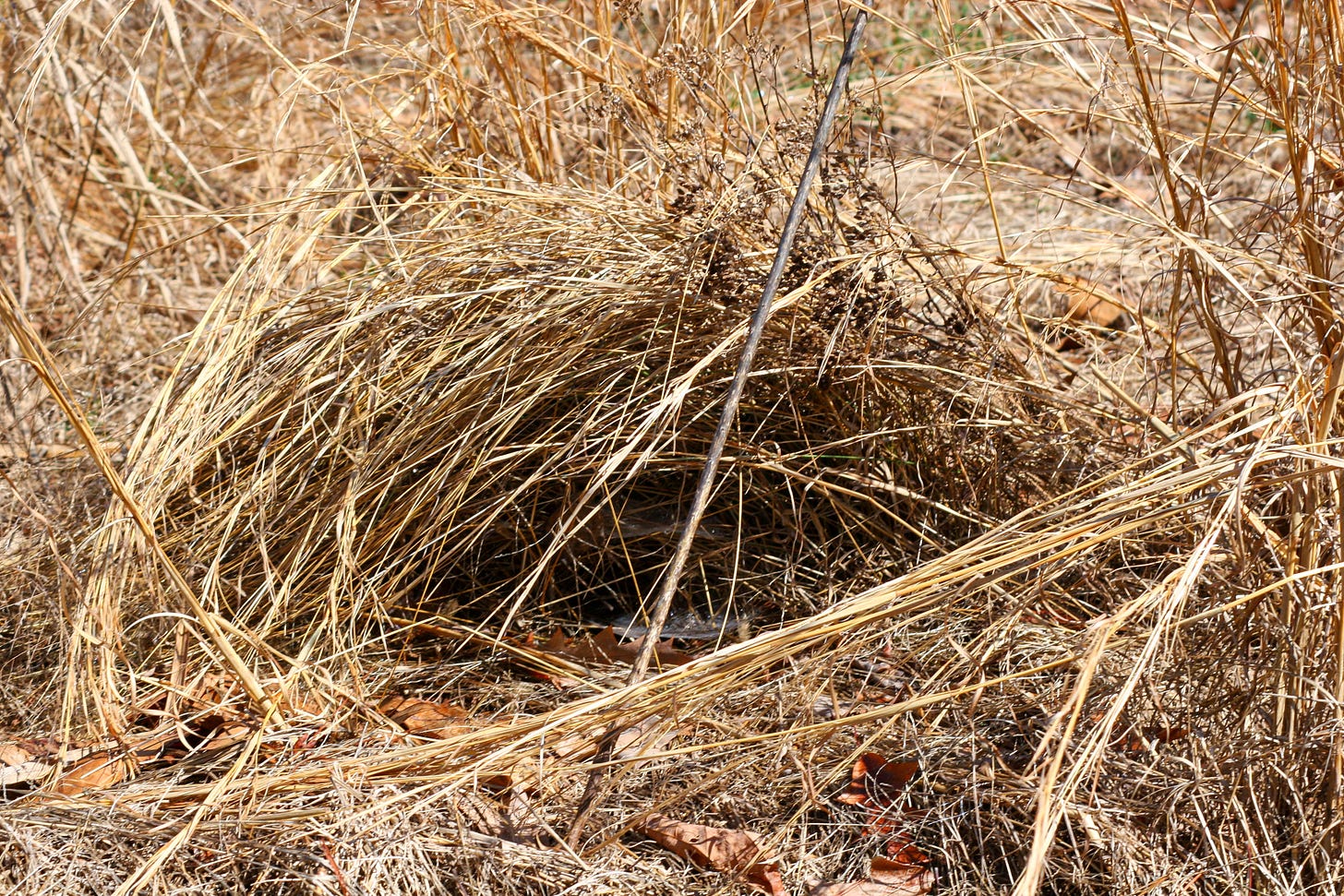Pollinator Friendly Fall Cleanup
Granny’s garden is a chore factory. From the inevitable mowing and weeding and edging and pruning and mulching and…and…and…
Fall is perhaps busiest of all; many gardeners approach fall cleanup with the zeal of a head nurse doing spring cleaning after the pandemic.
“Leaves!!!! Aaaacckkk!!!” You can hear many wailing. Others approach the leaf covered lawn with furious determination. Silently, with deadly purpose, they all remove each and every offending leaf and glare hatefully at any tree in the vicinity.
“Must. Get. Rid. Of. Leaves!” Much waving of leaf blower and bewailing of “nice” mulch blown off with the leaves. Much stalking of any sneaky leaves that have evaded their efforts until the last trembling leaf hiding under the porch has been routed.
Then, the Gods of Leaf Removal being appeased, eyes fasten on dead flowers stalks and other reminders of summer past. Repeat the leaves activity…”Dead flower stalks! Horrors! Must. Get. Rid. Of. Dead. Flower. Stalks!”
Only when the panting and wild eyed gardener can gaze upon a yard ravaged by their industry and see leaves lying only on the neighbor’s yard can they rest. Utterly spent, they finally go inside to hibernate until next spring, when a frenzy of digging and weeding and and mowing mulch replacement starts the process all over again.
Unfortunately, Granny’s hyper controlled yard, while being fabulous exercise, is yet another insult to a healthy environment. Leaf blowers aren’t just noisier than a car full of cub scouts on the sugar high of their lives, but can emit more hydrocarbons in an hour than a small truck would driving coast to coast. Then, there’s the pollinators themselves. Some bees and other pollinators are being driven to extinction by our overzealous practices.
Yes - we’ve met the enemy, and it’s us. So this fall, let’s get our exercise taking a walk and allowing some garden “chores” to remain undone until spring. If ever.
Those dead flower stalks that make Granny crazy can provide cozy bedrooms for tiny bees, who will emerge in spring’s warmth to pollinate early bloom (many bees are no bigger than a grain of rice but they’re fabulous pollinators). Trimming off just the tops of spent and seedless stalks can leave a hollow tube which is perfect for tiny bees. Some will overwinter in the stalks, others may lay their eggs there to hatch out when the weather warms. If stalks have fallen over already, try picking them up and placing them in an unused spot, perhaps under an evergreen with low branches. This loose pile of stalks is very similar to those “bee houses” you may have seen.
If a stalk is holding a bumper crop of seeds try leaving them alone. Goldfinches love to sit on stalks eating seeds.
Exhausted, deadened ghosts of beautiful foliage past. The once beautiful hostas, all yellowing sadly. So tempting to remove them and spread mulch to hide the area they once covered. If we bravely ignore the lifeless leaves, and resist the temptation to mulch where they once held sway, we’ll make a haven for little bees which just may pollinate next year’s flowers. We can help by simply leaving a bit of unmulched ground here and there (living mulch does this wonderfully; the green leaves shade the ground, leaving open soil beneath).
And leaves. Ah, the dread leaves (breathe calmly)! Leaves are the lifeblood of the forest, and not merely for the soil. Most butterflies and moths start their lives munching tree leaves as caterpillars. Our frenetic leaf removal, shredding, and other “chores” done in the cool fall weather kills thousands of these creatures, who not only won’t be there next spring, but won’t produce the offspring that are the best food for the birds we also love. The decline of our prettiest pollinators is a huge factor in the decline of our songbird populations.

The final Lepidoptera (butterflies and moths) season’s brood frequently rolls itself into a leaf to make a comfortable place to winter over. Other flyers lay eggs on the drying leaves to emerge in the spring. The leaves fall to the ground, where a few more leaves will keep the eggs and little juveniles warm and dry until spring, when little caterpillars emerges to climb a tree, shrub, or other tall plant to eat some more and pupate to become the gorgeous flyers we love. Most will be caught and fed to baby birds, who can’t eat hard food like seeds, but some will survive to bring joy to the summer garden.
This fall, let’s allow some leaves to just lie where they land. Healthy leaves are, in the end, excellent mulch in and of themselves, so allowing them to remain in mulched areas is only going to help your garden! If they all collect near a fence or hedge, you can gently remove the top layers and move those leaves to a needy leafless area in your yard (leave a healthy layer of leaves by the hedge).
Leaves on the lawn aren’t all bad, either. If you mow them rather than removing them, you’ll shred them in place, where, over the winter, they’ll break down, enriching the soil so that in the spring your lawn will take off without the need of excessive fertilizer (if any). After a few years of doing this, you’ll find your lawn remains greener longer in the dry summer months without watering - an incredible benefit to the plants and the stressed wells, aquifers, and reservoirs that provide all that water. Shredding will kill caterpillars but will allow some eggs on leaves to remain and hatch out in warmer weather.

The exception to this plan is diseased leaves. Fungus and some bacteria can overwinter on old leaves (bacterial problems usually overwinter in soil or mulches). But the leaves it’s already on are the issue, not the leaves from the unaffected tree nearby. If leaves haven’t yet started falling madly, now is the time to walk around the yard, removing diseased leaves. This may mean pruning your tree or shrub, and it’s a pretty good time to do exactly this, anyway. Then those diseased leaves won’t be an issue when the huge crop falls later.
Dead or old canes from raspberries, etc., are, like the spent flower stalks, marvelous homes for valuable pollinators during cold winter months. Resist the urge to prune them back to get a jump on spring’s chores and just enjoy the sight of birds sitting upon them.
Ornamental grasses that “flop” in winter are very much loved by birds to hide under during winter storms. It’s actually much warmer in the air under the “flop” than outside it. If you have a meadow, or ornamental grasses, don’t mow or cut it until late spring - if you feel you must mow it.

Dead branches. Dead branches - or those you’ve pruned - can be piled up in an unused corner. Dead branches provide winter cover for some birds and you may very well spot a woodpecker busily “attacking” them to forage for dinner. If you see bark tossed away like litter, very likely that’s what’s happened! Leave the branches there permanently, you can add to the pile, and you’ll create habitat for many bees - perhaps even an endangered salamander.
The new and improved rules of fall cleanup:
Allow fallen leaves to remain where they fall, except diseased leaves
Trim off only the tops of spent flower stalks leaving the hollow stem intact
Shred the leaves on the lawn with later season mowing - better, leave them intact until spring
Allow a few “bare earth” patches to remain, particularly where large leaves will hide them in summer
Place fallen branches in a pile for wildlife
Allow “flopping” grasses, etc., to remain until late spring
Further Reading
Xerces Society, “Put Down Those Pruners: Pollinators Need Your ‘Garden Garbage!’”
https://xerces.org/blog/put-down-those-pruners-pollinators-need-your-garden-garbage







